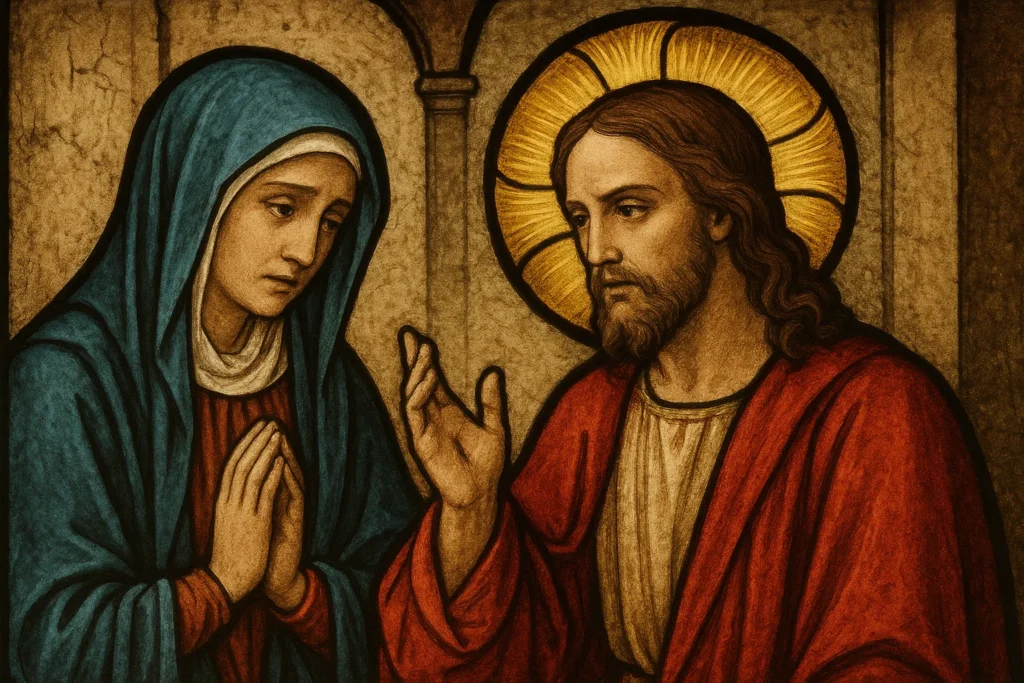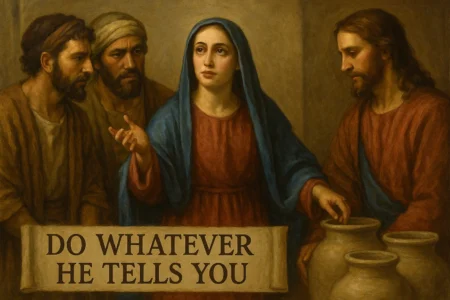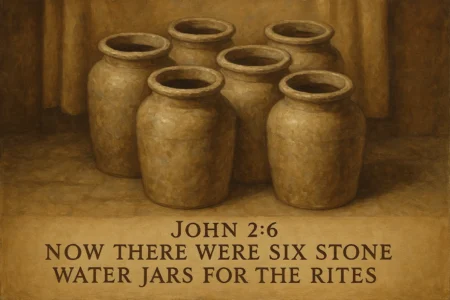It’s one of the most awkward, uncomfortable moments in the Gospels.
We’re at a party. A wedding in Cana. The mood is high, people are celebrating. And then, the ultimate social disaster: the wine runs out. Mary, Jesus’ mother, spots the crisis. She walks over to her son and, with that classic motherly understatement, just says, “They have no wine.”
She knows who he is. She knows what he’s capable of.
His reply? It lands like a lead balloon. “Woman, what does this have to do with me? My hour has not yet come.”
Ouch.
It feels cold. Dismissive. Bluntly disrespectful. Did he just call his own mother “Woman”? Did he really just brush off her concern? For centuries, this single verse has been a sticking point. Critics use it as “proof” of Jesus’ coldness, while believers have tied themselves in knots trying to explain it.
So, what is the true John 2:4 meaning? Is this just a moment of family friction, or is something much bigger, much deeper, going on?
Here’s the truth: this verse isn’t a snub. It’s a pivot. It’s one of the most profound turning points in his entire ministry. This is the exact moment Jesus steps out of his private life as “Mary’s son” and into his public role as the “Son of God.” He’s drawing a necessary line in the sand. This isn’t a story about disrespect. It’s a story about divine timing, a redefined relationship, and the beginning of everything.
Key Takeaways
- “Woman” Wasn’t an Insult: In the original Greek (“Gynai”), this was a formal, even respectful, title. Think “Madam” or “Ma’am,” not a rude jab. He even uses it tenderly with her from the cross.
- “What to me and to you?”: This is a clunky translation of a common Hebrew idiom. It doesn’t mean “Not my problem.” It means, “What does your concern (a social crisis) have to do with my mission (a divine one)?”
- “My Hour”: This is the real key. In John’s Gospel, “the hour” is code. It always refers to his ultimate purpose: his suffering, death, and resurrection. His “glorification.”
- A Sign, But Not The Hour: Jesus is essentially saying, “The main event, the cross, isn’t here yet.” But by doing the miracle, he signals that the time for his public signs has now begun—on his authority, not on human demand.
- Mary’s Incredible Faith: Her response is a masterclass in trust. She hears this complex, confusing answer and doesn’t argue. She just turns to the servants and gives the ultimate instruction: “Do whatever he tells you.”
The Elephant in the Room: Why Does Jesus Call Mary “Woman”?
Let’s just get right to it. That word. “Woman.”
If I ever called my mother “Woman,” I’m pretty sure I’d be ducking for a flying object. In our 21st-century world, the word is jarring. It’s what a fedora-wearing detective growls in a 1940s film noir, not what a loving son says to his mom.
It lands on our ears as cold. Impersonal. Totally devoid of affection.
But here’s the thing: we can’t judge an ancient text by our modern standards. We have to ask the right question.
Was “Woman” a Term of Disrespect in Ancient Judea?
No. Not at all.
In the original Greek, the word is gynai (g-oo-NAI). While it translates to “woman,” it carries none of the negative, dismissive baggage our English word has. It was actually a formal, polite, and even noble way to address someone. It’s the same term a king might use to address a queen. It conveys respect, not contempt.
Think of it like this. I still remember the first time a younger colleague called me “Sir.” It felt weird, almost cold. But I quickly realized, for him, it was pure respect. It signaled a different kind of relationship. This is like that, just magnified by 2,000 years of cultural change.
But the most powerful proof comes from Jesus himself.
This isn’t the only time he uses this word for his mother. He uses it one other time.
The last time.
He’s on the cross. He is in unimaginable agony. He looks down, and he sees Mary standing next to the disciple John. In one of his final, tender acts of love, he makes sure she’ll be cared for. He says, “Woman, behold your son.” Then he says to John, “Behold your mother” (John 19:26).
Nobody. Not a single person. Would ever accuse Jesus of being disrespectful in that moment. He is lovingly, tenderly, and with great finality, ensuring his mother’s future. He uses the exact same word: gynai.
In his moment of greatest agony, he uses this term of formal, profound, respectful love. This fact alone completely shatters the idea that the word is an insult.
So, if it’s not an insult, why use it? Why not just say “Mother”?
Because he’s signaling a change. A huge one. Their relationship is no longer just mother and son. He is now the Messiah, beginning his public work. She is now his disciple. He is establishing a new, public relationship that is defined by his divine mission, not just their family ties.
“What Does This Have to Do With Me?”: Unpacking a Misunderstood Phrase
Okay, so “Woman” is cleared. But the next part still stings.
“What does this have to do with me?”
This one really sounds like a teenager shrugging. “So what?” “Not my problem.” The family hosting the wedding is about to be humiliated, the party is about to die, and Jesus seems to say it has nothing to do with him.
Again, the translation is failing us. We’re reading a literal, word-for-word English rendering of a very common, very old Hebrew idiom.
Is This a Hebrew Idiom, Not a Literal Snub?
Yes. The literal Greek is, “What to me and to you?” This phrase, rooted in Hebrew, pops up elsewhere in the Bible. When King David’s general, Abishai, wants to execute a man for cursing the king, David fires back, “What have I to do with you…?” (2 Samuel 16:10).
David doesn’t mean “I don’t care about you.” He means, “Your concern and my concern are on two totally different levels right now. You’re thinking about my personal honor. I’m thinking about God’s will.”
This is exactly what Jesus is doing. A better, more dynamic translation of John 2:4 would be:
“Woman, what does your concern (running out of wine) have to do with my concern (my divine mission)?”
He isn’t dismissing the problem. He is elevating the purpose.
How Does This Set the Stage for Jesus’ Ministry?
This is the hinge. This is the moment everything pivots.
For thirty years, Jesus has been the son of Mary and Joseph. He would have fixed tables, obeyed his parents, and lived a perfectly normal, quiet life. In that life, Mary, his mother, could absolutely ask him for things.
But now… everything has changed.
He’s been baptized. The heavens have ripped open. The Spirit has descended like a dove. A voice from heaven has boomed, “This is my beloved Son.”
He is no longer operating as a private citizen. He’s on a divine clock now.
Jesus’ response is a gentle but firm declaration of independence. He is stating, for his mother and for everyone, that his actions from this day forward are not driven by human requests. Not by family ties. Not by social emergencies. They are driven only by the will of his Father and the divine timing of “the hour.”
He is moving from being the son of Mary to being the Savior of the world. This is a necessary realignment, and as we’ll see, Mary understands it with breathtaking faith.
The Big Mystery: What is “My Hour”?
This brings us to the theological heart of John 2:4.
“My hour has not yet come.”
This is the key. This phrase unlocks the entire passage. What on earth is this “hour”? And if his hour hadn’t come, why did he perform the miracle just a few minutes later? It looks like a total contradiction. He says “Not yet,” and then… he does it anyway.
This isn’t a contradiction. It’s a clarification.
If His “Hour” Hadn’t Come, Why Did He Do the Miracle Anyway?
When Jesus talks about “the hour” (Greek: hōra) in the Gospel of John, he’s almost never talking about 2:00 PM. He is referring to a specific, singular, climactic event.
“The hour” is his divine appointment with destiny.
This phrase is a drumbeat through John’s Gospel, getting louder and louder.
- In John 7:30, his enemies try to arrest him, “but no one laid a hand on him, because his hour had not yet come.”
- In John 8:20, he teaches in the temple, “but no one arrested him, because his hour had not yet come.”
- Finally, in John 12:23, right before his crucifixion, he says, “The hour has come for the Son of Man to be glorified.”
“The hour” is his Passion. It’s his suffering, his crucifixion, his death, and his resurrection. It is the entire purpose for which he came to earth.
So, back at the wedding, Jesus is telling his mother, “My ultimate, world-saving event—the cross—is not here yet.” He is distinguishing the start of his ministry from its culmination. He’s essentially saying, “Let’s be clear. This miracle I’m about to do? This isn’t the one. This isn’t the great sign. This is just the beginning.”
So, What “Hour” Had Arrived at Cana?
By saying, “My hour has not yet come,” he implies that an hour has. The hour for his public ministry. The hour for his “signs” to begin.
And notice the subtle but brilliant shift in power. Mary presents the need. Jesus responds by pointing to his divine mission (“my hour”). He seems to say “no,” or at least “not now.” Mary, in total faith, accepts this and simply tells the servants to be ready.
Then… Jesus acts.
The initiative has shifted. He doesn’t perform the miracle because his mom told him to. He performs it because his Father willed him to. He takes his mother’s request, filters it through his divine mission, and then, on his own authority and in his own time, he acts. He shows that he is in charge, not the human need.
This is a critical lesson. God’s timing isn’t our timing.
I’m a planner. My calendar is my life. I have everything scheduled, and I get deeply frustrated when things get moved or “it’s not time” for something I’m ready to do. Jesus’ response here always reminds me that there’s a profound, unbridgeable gap between my schedule and divine timing. He had “The Hour” (the ultimate plan), but he also had this moment (the immediate need). He showed that his grand plan didn’t stop him from acting in the present… but he would only act when the time was right.
How Does the “Hour” Connect to the Wine Itself?
The miracle itself is a clue to “the hour.” This isn’t just a random party trick.
First, the quantity. The six stone jars held 20 to 30 gallons each. That’s 120 to 180 gallons of wine. That is an outrageous, over-the-top, super-abundant amount. This kind of crazy abundance was a famous sign of the Messianic Age. The prophet Amos promised a day when “the mountains shall drip sweet wine, and all the hills shall flow with it” (Amos 9:13). Jesus is quietly announcing that the Messianic party has officially begun.
Second, the substance. He replaces the water of purification—a symbol of the Old Covenant rituals—with the wine of celebration. This is a living parable. The old way of ritual cleansing is over. The new, joyful, abundant life of the New Covenant is here.
Finally, the wine points directly to his “hour.” The next time Jesus miraculously provides wine, it’s at the Last Supper. He will hold up a cup and say, “This is my blood of the covenant, which is poured out for many” (Mark 14:24).
The wine at Cana is the first bookend. The wine at the Last Supper is the second. Both point to “the hour” when his blood would be poured out, bringing true cleansing and ultimate joy.
What Can We Learn From Mary’s Reaction?
Jesus’ words in John 2:4 are complex, theological, and confusing.
Mary’s response is beautifully simple.
She hears this cryptic, challenging, “what-does-that-even-mean” reply. And what does she do? She doesn’t argue. She doesn’t get offended. She doesn’t pout or say, “After all I’ve done for you!”
No. She simply turns to the servants and says five of the most powerful words in the Bible:
“Do whatever he tells you.”
“Do Whatever He Tells You”: A Masterclass in Faith?
This is radical trust. This is the model for all discipleship.
Think about what she’s doing. She hears his answer, which separates his mission from her request. She completely accepts it. She doesn’t know how he will solve the problem. She doesn’t even know if his words meant “yes” or “no.”
She just knows who he is.
So, she puts the ball entirely in his court. She points the servants—and all of us—away from herself and directly to him. She prepares them to obey, no matter how strange the command.
And the command was strange. “Fill those giant purification jars with… water.” The servants must have thought he was nuts. “The man wants water? They need wine!” But they obey. Because Mary had prepared them. And they became the first people to witness his glory.
Mary models true intercession. She doesn’t demand. She doesn’t dictate the solution. She simply presents the need (“They have no wine”) and then steps back in total trust, telling everyone else to get ready to obey.
We can see this powerful pattern of faithful trust in other biblical figures. The [suspicious link removed] stands as a classic example of someone holding onto faith in a reality that, like Jesus’ words to Mary, made no logical sense at the time.
How Does Mary’s Role Change in This Moment?
This is the last time Mary is seen “directing” Jesus in any way. From this point on, she is no longer just his mother; she is his first and greatest disciple.
She shifts from a position of parental authority to a position of faithful follower. Her last recorded words in the entire Bible are, “Do whatever he tells you.” She could not have left us with a more perfect summary of the Christian life. She who “treasured up all these things in her heart” understood. She knew his mission was bigger than her, bigger than a wedding, bigger than family.
And she was all in.
Putting It All Together: The True Meaning of John 2:4
So, we come full circle. We started with a verse that felt cold, harsh, and disrespectful. Now, we see it as a pivotal, profound, and necessary moment of transition.
John 2:4 is not a story of family drama. It is a “changing of the guard.” It is the precise instant Jesus’ public ministry begins, and he uses this moment to teach his mother, his disciples, and us about his identity and his mission.
So, Was Jesus Being Disrespectful? A Final Verdict.
No. He was being precise.
He was not being a cold son. He was being the obedient Son of God. He used a formal, respectful title (“Woman”) to signal that their relationship was now public and centered on his mission. He used a common idiom (“What to me and to you?”) to clarify that his actions were driven by a divine plan, not just a human one. And he used a theological term (“My hour”) to point all of humanity toward the ultimate goal: the cross and resurrection, the only event that could truly solve our “running out of wine” problem.
What Does John 2:4 Mean for Us Today?
This single, puzzling verse becomes a powerful guide for our own faith.
As a father, I’ve had my kids run up to me, needing something right now. A snack, help with a toy, a scraped knee. Sometimes, it’s something I fully intend to give them, but I have to say, “Not right now. Wait a second.” The timing isn’t right. I’m not dismissing them; I’m operating on a bigger picture they can’t see, one that involves the whole family’s schedule. This verse feels like that, on a cosmic, divine scale.
We are all at the wedding in Cana. We all run out of wine. We all have desperate, urgent needs—in our finances, our health, our relationships. And we bring them to Jesus.
Sometimes, his answer feels just like John 2:4. It feels like, “Not yet.” It feels confusing. It feels like he’s saying, “What does your crisis have to do with my grand plan?”
This story teaches us how to respond.
- We can bring our “empty jar” problems to God. Like Mary, we can be honest and direct about the need. We don’t have to pretend we have it all together.
- We must trust His response. Even if it sounds like “not yet” or something we don’t understand, we have to trust that He is operating on a divine timetable for our ultimate good.
- We must be ready to “do whatever he tells us.” This is the hardest part. Our solution is “make wine.” His instruction is “fill jars with water.” We must have the faith of those servants to obey, even when the command makes no sense, trusting that his “water” will become the “wine” we truly need.
The First Sign
In the end, John 2:4 is not a barrier to faith; it is a doorway. It’s the moment Jesus clarifies his purpose. It’s the moment Mary models perfect discipleship.
It’s the moment the water of the old ways began to turn into the wine of the new kingdom.
This wasn’t just a favor for his mom. It wasn’t just saving a family from shame. John, the author, tells us exactly what it was. Immediately after the miracle, he writes, “This, the first of his signs, Jesus did at Cana in Galilee, and manifested his glory. And his disciples believed in him.”
Jesus’ hour for the cross had not yet come. But his hour to manifest his glory—to show us who he was—had arrived. And it all began with this beautifully complex, misunderstood, and mission-defining conversation.
FAQ – John 2:4
Why does Jesus call his mother ‘Woman’ in John 2:4, and does this indicate disrespect?
In the original Greek, ‘Woman’ (gynai) was a formal and respectful term, not a disrespectful insult. Jesus used it to signal a shift in their relationship from familial to a divine mission, especially as he was establishing his public role and divine purpose.
What does the phrase ‘What does this have to do with me?’ mean in the cultural context of the Bible?
This phrase is a Hebrew idiom meaning that Jesus was distinguishing his divine purpose from the immediate social concern. It emphasizes that the issue of running out of wine is not separate from his divine mission, which is about fulfilling God’s timing and plan.
What is meant by ‘My hour’ in John’s Gospel, and why is it important?
‘My hour’ refers to Jesus’ ultimate purpose—his suffering, death, and resurrection. It marks the climactic moment in his divine mission, indicating when he publicly reveals his identity and begins his redemptive work, culminating in the cross.
What lessons about faith can we learn from Mary’s response to Jesus at the wedding in Cana?
Mary’s response teaches us to trust and obey Jesus completely, even when his answers or actions are confusing. Her example of faith—simply telling the servants to do whatever Jesus instructs—is a model of perfect discipleship and reliance on divine guidance.



